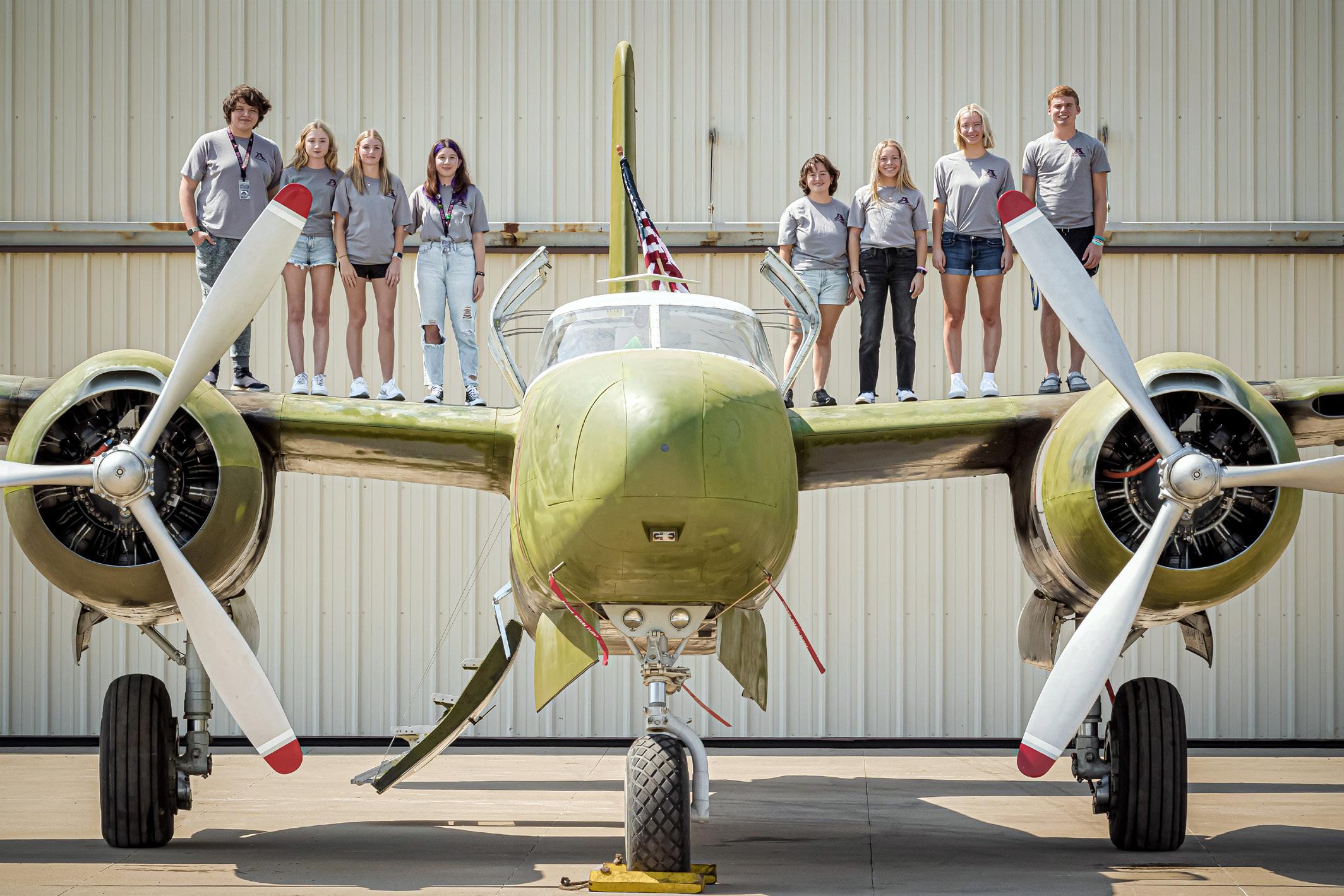
3 minute read
The Sky Is Calling Oklahoma Aeronautics Moves to Strengthen Aviation Education in Oklahoma.
By Paula Kedy
Recognizing the need to arm a workforce for the state’s growing aerospace industry, the Oklahoma Aeronautics Commission has developed a rollout of aviation curricula designed for students to gain the STEM skills necessary to move into postsecondary education or industry careers. At the forefront of the initiative is the implementation of the Aircraft Owners and Pilots Association (AOPA) “You Can Fly” High School Aviation Curriculum, a four-year curriculum that is free to schools. You Can Fly offers schools the choice of a general aviation/pilot pathway or a UAS/drone pathway. Both provide students with in-depth exposure to a myriad of careers in aerospace and aviation.
“For two consecutive years, Oklahoma has been named number one in the nation in the number of schools offering the AOPA curriculum, with 87 high schools slated to implement the curriculum in 2023-2024,” said Grayson Ardies, State Director of Aeronautics. “The curriculum helps build strong foundations in pre-engineering, mathematics, and science that are necessary to support Oklahoma’s second-leading industry, aerospace.”
The Commission also works to support the implementation of “Choose Aerospace,” a curriculum designed to prepare juniors and seniors for careers in aircraft maintenance. Choose Aerospace is an online curriculum offered with the support of the Oklahoma Department of Career and Technology Education and various industry partners.

Runways of Learning
What started as a field test of the AOPA curriculum by Ada High School in 2017 has quickly become an integral part of course offerings in schools across the state. More than that, districts are thriving from the development of partnerships with aerospace industries, airports, and workforce development committees. David Day, Director of the Pryor Public Schools Innovation Center, said, “The aviation program at Pryor Public Schools has given our students the skills and knowledge they will need to pursue a career in aviation. Students are learning about aircraft systems, flight planning, and weather. They are currently building an RV-12 Sport Aircraft and are utilizing drones of all types. The aviation program at Pryor High School has truly been a gamechanger.”
During the 2022 legislative session, aviation coursework was approved for graduation core credit, making it easier for students to enter the aviation pathway and to develop the Individual Career Academic Plan (ICAP) required for graduation.

Sam Madewell, the Choose Aerospace instructor for Putnam City Schools, worked this year with the AAR Corporation maintenance base at Will Rogers World Airport to develop internships for four students. “The students were able to learn firsthand the skills necessary to become aircraft maintenance technicians,” said Madewell. “The internships truly impacted their career pathways, and we appreciate the willingness of AAR-Oklahoma to work with our students.”
Ready for Takeoff
Some school districts are already experiencing the rewards of having students graduate from pathways of aviation coursework and enter postsecondary programs. Oklahoma State University sophomore David Anderson, a graduate of Ada High School’s aviation program, is currently majoring in finance with a minor in aviation. “My goal is to become an aircraft broker, taking clients on test flights and building business relationships,” said Anderson. “I gained most of my flight hours before graduating from Ada High School and received my private pilot certification last year. I plan to surround myself with aviation. The AOPA curriculum has provided me with opportunities I never knew existed.”
Anderson is representative of students across Oklahoma who are setting rewarding career goals and readying themselves to enter the aerospace industry. The Oklahoma Aeronautics Commission is committed to supporting the quality implementation of aviation and aerospace education programs across the state and will continue to work to ensure that Oklahoma is ready to fly. ■
State Director of Aeronautics, Grayson Ardies, and Oklahoma Aeronautics Commission staff recently visited with Lt. Governor Matt Pinnell, who serves as the Secretary of Workforce Development for the state. The group discussed the growth of aviation education in Oklahoma and the importance of educating a trained workforce.

Lifelong educator Paula Kedy serves as the Aerospace and Aviation Education Coordinator for the Oklahoma Aeronautics Commission. In her previous role as Ada City Schools’ Executive Director of Academics, Kedy was the first in the state to field test the AOPA aviation curriculum at Ada High School in 2017. She now works to promote aviation education across Oklahoma by sharing the importance of the AOPA You Can Fly High School Aviation Curriculum. The Commission was recently awarded the Most Innovative State Program Award at the 2022 National Association of State Aviation Officials Conference for its work in implementing aviation education in over 50 Oklahoma high schools.
Kedy serves on the national AOPA High School Steering Committee and has been named to the advisory committees of Sooner Flight Academy, Southeastern Oklahoma State University Aviation Science Institute, and the Spartan College of Aeronautics & Technology. She has helped to develop five Oklahoma Aviation High Schools of Excellence (at Ada, McAlester, Mustang, Okmulgee, and Pryor High Schools) through the implementation of an FAA 625 Workforce Development Grant and is committed to helping ensure equitable aviation STEM opportunities for Oklahoma students. School districts interested in learning more about aviation curricula may contact Kedy at pkedy@oac.ok.gov











